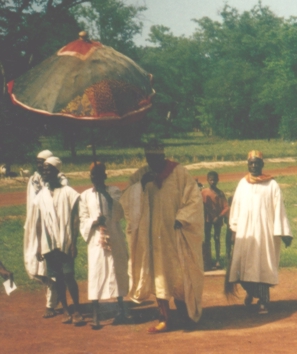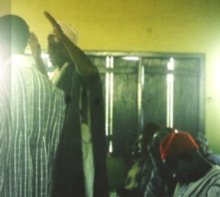

The Sandemnaab is arriving in his car
The Sandemnaab and some of his elders
Swearing in of the Bulsa chiefs in 1973
Monday, 23rd July, 1973 was a great day for Sandema and the whole Bulsa District. Early in the morning people came together on the large square which is now the lorry station of Sandema. The Sandemnaab’s drummer beat the talking drums and narrated about the glorious history of Sandema and the Bulsa. A small music band consisting of two calabash drums, one hourglass drum and basketry rattles was entertaining the visitors, although dances should only have started after the planned political ritual had taken place. Small groups of chiefs with their elders (nisoma) and their headman (kambonnalima) were arriving. The
 |
 |
|
The Sandemnaab is arriving in his car |
The Sandemnaab and some of his elders |
chiefs were wearing their red caps, a symbol of chieftaincy, big brass finger-rings, and chains of pearls, sometimes worn like a belt. The last chief to arrive was the Sandemnaab. He left his big white car and in very slow steps and under the chiefly umbrella he strode to the meeting hall.
The clothes of the second group of protagonists contrasted sharply with those of the traditional chiefs: all the lawyers and government representatives from Bolgatanga, then the capital of the Upper Region, were wearing dark suits with white shirts and ties.
At 10.30 a.m. (after a one-and-a-half-hour delay) chiefs, lawyers and spectators had assembled in the meeting hall.
The reason for this meeting was historic. The chiefs would be given back their lower jurisdiction, which they had possessed in colonial times, but had lost under Nkrumah’s rule. In the beginning one of the White Fathers of Wiaga (Fr. Marneffe?) led a prayer in English and Buli. Then the lawyers and other high officers were introduced and the Sandemnaab held a speech in Buli. In a paternal way the High Court Judge tried to explain in English (translated by a Bulsa interpreter) how the chiefs should administer justice: All people, even the chiefs’ relatives, should be treated equally, and they should never be afraid of any threats.
After this the chiefs, one by one, came forward to a table to be sworn in. Lying on the table were a Bible, a wooden cross and a Koran, and the chiefs could choose one of them to swear by. Only two chiefs (the Sandemnaab and the Wiaganaab) swore by the Bible, one (Leo Amoabil, the Wiesinaab) swore by the
 |
|
The Uwasi chief is swearing his oath
|
cross and none by the Koran. Although the High Court Judge instructed them that those who did not swear by a sacred object, should raise their left hand, nearly all these chiefs swore by stretching out both arms, as it is the custom in Bulsa tradition. The Chuchuliganaab (Asangalisa), an old stout man with glasses and a white beard, did not repeat the form of oath literally but tried to comment on the text and ask questions. Without having spoken the pre-formulated text he said that he agreed with everything and sat down.
After the swearing in of the chiefs, the State Attorney, a fairly young man, held a speech and told the listeners that a month ago the chiefs had been thoroughly instructed about their new rights and duties and that the low jurisdiction comprised problems of land tenure, marriage and divorce. All judgement should be passed according to the customary law, but witnesses should enjoy the same protection as in civil courts. Fines could be imposed up to an amount of 200 Cedis (approximately $ 400 in 1973), imprisonment for up to one year. If there were any problems or doubts, professional lawyers should be consulted.
The concluding speech was held by the chief of Wiesi and was translated into Buli. The rest of the day was passed with music, dances and general enjoyment on the big square in front of the meeting hall.
The lower jurisdiction of the chiefs is still valid today.